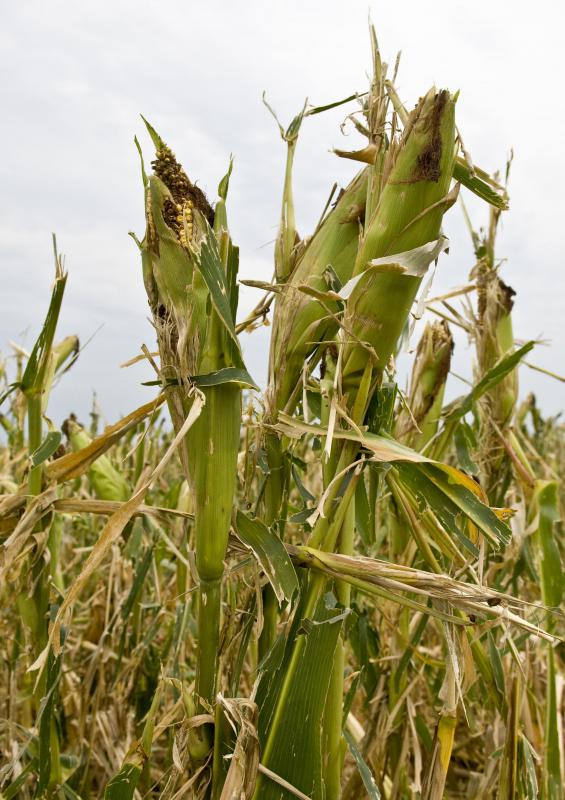At AllThingsNature, we're committed to delivering accurate, trustworthy information. Our expert-authored content is rigorously fact-checked and sourced from credible authorities. Discover how we uphold the highest standards in providing you with reliable knowledge.
What Are the Different Types of Crop Diseases?
Every year, agricultural producers lose vast quantities of crops to various crop diseases. To understand how and why certain diseases strike certain crops, plant pathologists have categorized all diseases into two general groups, infectious and non-infectious. Once segmented into one of the categories, diseases are then described by the characteristic of the offending pathogen or environmental cause, such as fungal, bacterial, extreme temperatures or soil deficiency. Finally, horticulturalists further classify a disease by the part of the crop that is affected, such as leaf diseases, root diseases and more. There are multitudes of different types of crop diseases, but all diseases basically fall under the category of infectious and non-infectious for further classification.
Non-infectious, or abiotic, diseases are those that are caused by unfavorable environmental circumstances and that do not result from living organisms. Generally, non-infectious diseases tend to weaken a plant, making the plant susceptible to the more serious infectious diseases. Examples of non-infectious diseases include extreme temperatures, excessive or lack of water, insects, poor soil nutrition content and toxic chemicals. These factors can weaken the entire plant or a certain part of the plant, making the plant susceptible to infectious stem diseases, seed diseases, pod diseases and more.

Infectious, or biotic, diseases make up the bulk of variety of crop diseases. These are caused by living organisms that infect the crop. Fungi, such as smuts, rusts, molds and blights, are the most common cause for crop diseases. Most fungi require very moist conditions in which to thrive and reproduce. Some fungi develop pustules on the crops, while others produce a colony of powdery, discolored soot.

Bacteria and viruses, which are other infectious hosts, are tiny organisms that infiltrate the plant organs and reproduce. Some bacteria do not harm crops, but others can produce toxins or attack the plants' cells for food. Viruses are usually spread by insects when an insect chews through the plant's protective outer layer and infiltrates the inner cells. Bacterial blights and wilts often plague wheat and barley crops as well as vegetables, such as cucumbers and beans. Crop diseases caused by viruses can cause considerable damage, such as wheat streak mosaic virus and potato virus diseases than can eradicate an entire crop very quickly.

Nematodes and protozoa are also classified as infectious diseases. These tiny worm-like organisms reside in the soil, waiting for an opportunity to attack a crop weakened by non-infectious causes. They may carry viruses, causing further damage to crops and complicating disease treatment. Examples of these biotic diseases include the potato cyst nematode, pine wilt and soybean cyst nematode. As ascertained from their names, these crop diseases invade the sensitive root or vascular systems of the crops and cause cysts that stunt plant growth and sharply decrease crop yields.

Curbing or curing crop diseases is big business. Scientists and agriculturalists have developed myriads of fungicides, insecticides, pesticides and antibacterial solutions for crop disease control. While advances have been made, pathogens have shown a tenacious propensity to adapt to repellants. As the agriculture industry learns more about the various types and causes of crop diseases it becomes better equipped to treat and prevent the many diseases that plague the world's crops.
Frequently Asked Questions
What are the main categories of crop diseases?

Crop diseases are primarily categorized into three types: fungal, bacterial, and viral. Fungal diseases, like rusts and mildews, are the most prevalent, affecting a wide range of crops. Bacterial diseases, such as blights and wilts, can rapidly spread under warm, moist conditions. Viral diseases, including mosaic and yellowing diseases, often result in stunted growth and reduced yields.
How do fungal diseases typically affect crops?
Fungal diseases are notorious for their ability to devastate crops by attacking various plant parts. They can cause leaf spots, rots, and blights, leading to significant yield losses. According to the American Phytopathological Society, fungal diseases can reduce crop yields by 10-80%, depending on the pathogen and environmental conditions.
Can crop diseases be effectively managed or prevented?
Yes, crop diseases can be managed through integrated pest management (IPM) strategies, which include crop rotation, resistant varieties, proper irrigation, and timely application of fungicides or bactericides. The Food and Agriculture Organization emphasizes the importance of early detection and sustainable management practices to minimize the impact of crop diseases.
What impact do viral diseases have on crop production?
Viral diseases can severely impact crop production by causing symptoms such as mottling, yellowing, and stunted growth. These diseases are often transmitted by insect vectors, making control challenging. Crop losses due to viral infections can be substantial, with some diseases capable of causing total crop failure under severe infestations.
Are there any emerging crop diseases that farmers should be aware of?
Farmers should be vigilant about new and emerging crop diseases, such as Wheat Blast and Banana Fusarium Wilt (TR4), which pose significant threats to food security. Global trade and climate change are factors that contribute to the spread of these diseases, making continuous monitoring and research essential for early detection and response.
What role does climate change play in the prevalence of crop diseases?
Climate change plays a significant role in the prevalence and distribution of crop diseases. Warmer temperatures and altered precipitation patterns can create more favorable conditions for pathogens, potentially increasing their range and severity. Studies suggest that climate change could lead to a 10-25% increase in crop disease prevalence in certain regions, impacting global food production.
AS FEATURED ON:
AS FEATURED ON:















Discuss this Article
Post your comments